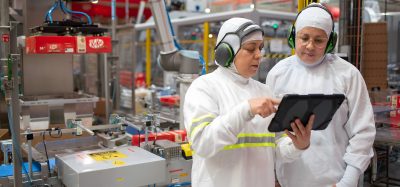Innovative freezing technologies for foods
Posted: 6 September 2012 | Stephen J. James & Christian James, Food Refrigeration and Process Engineering Research Centre, Grimsby Institute of Further and Higher Education | No comments yet
Freezing is a well-established food preservation process that produces high quality nutritious foods that offer the advantage of a long storage life. However, freezing is not suitable for all foods and freezing does cause physical and chemical changes in many foods that are perceived as reducing the quality of the thawed material.
There is a general view that fast freezing, and the formation of small ice crystals, offers some quality advantages. However, this is not true of all foods. For example, while freezing rate may affect drip in meat there is no evidence that it has any substantial influence on its final eating quality. Nevertheless, many innovative freezing processes are currently being researched and developed across the globe to improve freezing times and product quality.
Some innovative freezing processes (impingement and Hydro-fluidisation) are essentially improvements of existing methods (air blast and immersion, respectively) that by providing far higher surface heat transfer rates than previous systems, aim to improve product quality through rapid freezing. In these cases, the advantages may depend on the size of the product, since the poor thermal conductivity of many foods limits the rate of cooling in large objects rather than the heat transfer between the cooling medium and the product.
Freezing is a well-established food preservation process that produces high quality nutritious foods that offer the advantage of a long storage life. However, freezing is not suitable for all foods and freezing does cause physical and chemical changes in many foods that are perceived as reducing the quality of the thawed material. There is a general view that fast freezing, and the formation of small ice crystals, offers some quality advantages. However, this is not true of all foods. For example, while freezing rate may affect drip in meat there is no evidence that it has any substantial influence on its final eating quality. Nevertheless, many innovative freezing processes are currently being researched and developed across the globe to improve freezing times and product quality. Some innovative freezing processes (impingement and Hydro-fluidisation) are essentially improvements of existing methods (air blast and immersion, respectively) that by providing far higher surface heat transfer rates than previous systems, aim to improve product quality through rapid freezing. In these cases, the advantages may depend on the size of the product, since the poor thermal conductivity of many foods limits the rate of cooling in large objects rather than the heat transfer between the cooling medium and the product.
Freezing is a well-established food preservation process that produces high quality nutritious foods that offer the advantage of a long storage life. However, freezing is not suitable for all foods and freezing does cause physical and chemical changes in many foods that are perceived as reducing the quality of the thawed material.
There is a general view that fast freezing, and the formation of small ice crystals, offers some quality advantages. However, this is not true of all foods. For example, while freezing rate may affect drip in meat there is no evidence that it has any substantial influence on its final eating quality. Nevertheless, many innovative freezing processes are currently being researched and developed across the globe to improve freezing times and product quality.
Some innovative freezing processes (impingement and Hydro-fluidisation) are essentially improvements of existing methods (air blast and immersion, respectively) that by providing far higher surface heat transfer rates than previous systems, aim to improve product quality through rapid freezing. In these cases, the advantages may depend on the size of the product, since the poor thermal conductivity of many foods limits the rate of cooling in large objects rather than the heat transfer between the cooling medium and the product. Other processes (pressure shift, magnetic resonance, electrostatic, microwave, radio frequency, ultrasound) are adjuncts to existing freezing systems that aim to improve product quality through controlling the way that ice is formed in the food during freezing. An alternative is to change the properties of the food itself to control how ice is formed during freezing (such as in dehydrofreezing and the use of antifreeze and ice-nucleation proteins).
Impingement freezing
The use of impingement technology to increase the surface heat transfer in air freezing systems has been one of the few recent innovations that have been truly commercially realised. Impingement is the process of directing a jet or jets of air at a solid surface to affect a change. The very high velocity (20 – 30 ms-1) impingement air jets, ‘breakup’ the static surface boundary layer of gas that surrounds a food product. The resulting medium around the product is more turbulent and the heat exchange through this zone becomes much more effective. Impingement freezing is best suited for products with high surface area to weight ratios (i.e. products with one small dimension, such as burgers or fish fillets). Testing has shown that products with a thickness of less than 20 millimetres freeze most effectively in an impingement heat transfer environment. The process is also very attractive for products that require very rapid surface freezing and chilling.
Hydro-fluidisation freezing
Hydro-fluidisation (HF) freezing is essentially a form of immersion freezing. It may be considered analogous to liquid impingement freezing. HF freezing uses a circulating system that pumps the refrigerating liquid upwards, through orifices or nozzles, in a refrigerating vessel, thereby creating agitating jets. These form a fluidised bed of highly turbulent liquid and moving products and thus provide extremely high surface heat transfer coefficients that enable rapid freezing1. There is some published research literature related to the design of HF systems2, but little data on foods, and little evidence as yet of it being attempted commercially.
High pressure assisted freezing
High pressure freezing (using pressures of 200 to 400 MPa), and in particular ‘pressure shift’ freezing, has attracting considerable scientific interest in recent years1,3-5.
When water is frozen at atmospheric pressure, its volume increases which causes tissue damage in foods. However, theoretically freezing under high-pressure results in different ice being formed that has a greater density than water, does not expand in volume during formation and exists in a ‘vitreous’ noncrystalline state, which may reduce tissue damage. At a pressure of 200 MPa the freezing point drops to approximately -22°C, enabling a depth of vitrification of around 200 μm, so that objects with a thickness of up to 0.4-0.6 millimetres could be well frozen1. With pressure shift freezing, the food is cooled under high pressure to sub-zero temperatures but does not undergo a phase change and freeze until the pressure is released. Rapid nucleation results in small, even ice crystals. Thus, nucleation theoretically occurs instantaneously and homogenously throughout the food. This should result in a reduced duration of the phase transition, less mechanical stress during formation of the ice crystals and smaller ice crystals with a uniform distribution throughout the food. In theory, this would be especially useful when freezing foods with large dimensions in which the poor thermal conductivity of many foods results in thermal gradients that make it difficult to reach fast freezing rates within the centre of such foods.
While studies have shown pressure shift freezing can produce smaller more widely distributed ice crystals in many products, it remains to be established whether this results in a commercially better product. For example, studies on pork and beef6 have failed to show any real commercial quality advantage with these foods. Capital cost of equipment is one obstacle holding back further development of pressure shift freezing, as is the inherent batch nature of the current process and the long precooling step required before nucleation; however, the penetration of other high pressure processes into the food industry may begin to solve these problems.
Ultrasonic assisted freezing
While ultrasonically assisted thawing has been a proven process for a relatively long time, its use to assist freezing is more recent. Research has mainly utilised ‘power ultrasound’7,8, a form of ultrasound wave with low frequency (18-20 kHz to 100 kHz) and high intensity (generally higher than 1 W/cm2). In theory, the ultrasound creates cavitation bubbles throughout the product, which promotes more even ice nucleation and fragment ice crystals already present into smaller crystals. It may also accelerate con – vective heat transfer in the cooling media, thus speeding up the freezing process. While Zheng & Sun7 suggested possible ways for integrating ultrasonic devices to some commercial freezing equip – ment (such as air blast and plate freezers), as yet we are not aware of any commercial-scale ultrasonic assisted freezing installation, though laboratory level research is still on-going.
Magnetic resonance assisted freezing
A Japanese patented system called CAS (Cells Alive System) freezing, which involves variable magnet fields, has been marketed by ABI (Japan) for enhanced freezing and frozen storage of foods1,9,10. The CAS technology claims to “retain the texture and flavour of food”9,10 by enhancing supercooling of the product, achieved by subjecting the target product with a lowintensity magnetic field, prior to freezing (essentially the same aim as pressure-shift freezing), although the authors of this article have not seen enhanced supercooling in the ABI pilot scale CAS rigs installed at the Grimsby Institute. It is also reported that “pulsating air minimises the formation of ice clustering”, the food is also pulsed “with an oscillating magnetic field during storage” which is reported to reduce bacteria numbers and allow “the products to be kept for two to three years, or even longer”9.
As yet, although full scale commercial ABI CAS installations have been reported in Japan, there is very little peer-reviewed published work on magnetic resonance assisted freezing. Some reports on CAS assisted freezing of biological samples (such as teeth) have been recently published, but nothing on food. An independent study by Suzuki et al11 using a ‘copy’ of the ABI CAS system reported that the system had no effect on the quality of sweet potato, spinach, fish, agar gel and water. The results of (unpublished) trials using pilot scale ABI CAS systems at the Grimsby Institute have been variable, depending on product and freezing conditions employed.
Electrostatic assisted freezing
Electrostatic assisted freezing at present has only been investigated, so far, on a laboratory scale in model systems12,13. The principle is that applying an electric field to a food will orientate the polar molecules, such as water, thus controlling super-cooling and ice crystallisation. It has not, as yet, been assessed in a food system.
Microwave assisted freezing
The potential of microwaves to assist freezing has been studied by a few researchers14,15. The proposed principle behind microwave assisted freezing is to exploit water dipole rotation induced by microwaves to disrupt ice nucleation and formation during freezing. Both studies showed some potential but the applications were for the cryopreservation of small biomaterials, and one15 used a cryoprotectant (ethylene glycol). Although little work has been published since, Samsung Electronics have patented a device utilising microwaves to prevent spontaneous nucleation of supercooled liquid during storage12 and a study has been recently published utilising radio-frequency to assist freezing of pork.
Radio-frequency assisted freezing
Work has recently been published on the potential of radiofrequency (RF) to assist food freezing16. The proposed principle behind microwave and radio-frequency assisted freezing is similar to that of microwave assisted freezing, i.e. to exploit water dipole rotation induced by microwaves to disrupt ice nucleation and formation during freezing. It may also depress the freezing point thus producing more nucleation sites. The published study by Anese et al16 demonstrated that cryogenic (liquid nitrogen) freezing of pork meat assisted by low voltage RF pulses (2 kV) produced much fewer intercellular voids and cell disruption to the microstructure of meat when RF was applied. In comparison to the conventionally frozen samples, RF frozen meat had smaller ice crystals that were mainly intracellular.
Dehydrofreezing
Despite being often cited as a new, novel or emerging technology, the concept of dehydrofreezing is not new, with published studies carried out since the 1950s. Dehydrofreezing is an adjunct to freezing in which a food is first dehydrated to a desirable moisture and then frozen4. The theory behind this process is that since fresh fruits and vegetables contain more water than meat and their cellular structure is less elastic, reducing the water content prior to freezing reduces the freezing time, the initial freezing point and the amount of ice formed within the product. This potentially reduces damage and improves product quality. Reducing the water load will also reduce the amount of energy required to freeze by reducing the heat load. Reducing mass may also reduce distribution costs. Most studies have removed water from the fruits and vegetables prior to freezing by osmotic dehydration in sugar (for fruits) or sodium chloride (for vegetables) solutions, or have used air drying. Osmotic dehydration methods have generally been preferred over air drying. Such a process may be particularly suited to products destined for use as ingredients in processed foods.
Antifreeze proteins
Early interest in antifreeze proteins was famously caused by the observation of the survival of fish inhabiting polar and northern coastal waters, whose freezing point is below the plasma freezing point of the fish. Antifreeze proteins have since been identified also in many invertebrates, fungi, bacteria and plants4. The function of the antifreeze proteins is to lower the freezing temperature and suppress the growth of ice nuclei, thus inhibiting ice formation, altering ice crystal growth and retarding recrystallisation on frozen storage. The use of antifreeze proteins will depend on cost, safety and consumer acceptance4,17. One application of antifreeze proteins that is already finding use in the food industry is in low-fat ice creams and frozen yogurts. However, this is not without controversy due to some of these proteins being genetically modified.
Ice-nucleation proteins
Ice-nucleation proteins are a functionally distinct and opposite class of protein to antifreeze proteins produced by some Gram negative bacteria4,17,1. The function of an icenucleation protein is to raise the temperatures of ice-nucleation and reduce the degree of supercooling, thus shortening the freezing time and aiding the nucleation of ice throughout the product. In theory, this may lead to beneficial changes in the texture of frozen foods4. However, such proteins are bacterial in origin and one major concern is the safety of such bacteria and how to make sure that inedible microorganisms are killed completely before the food is consumed4.
Conclusions
Many innovative technologies currently being researched and developed promise improve – ments in the quality of frozen foods. Some of these innovative technologies are in the development stage, while for others the biggest obstacle is high capital cost. It is also not clear how well small ice crystal structures are maintained during subsequent storage, as ice crystals over time will agglomerate, the phenomenon known as Ostwald ripening. Some of these technologies potentially offer energy savings, primarily through reducing the freezing time. Others may offer quality advantages at the cost of greater energy or cost. In such cases it remains to be established how important quality versus cost is to the consumer. One issue that can hold back the adoption of novel technologies by the food industry are worries of consumer acceptance. Few studies have been carried out on what consumers may think of the innovative freezing technologies discussed in this article. However, one study has addressed high pressure freezing19. This survey found that their respondents generally had neutral attitudes towards this process, and found that price was the most important factor influencing their purchasing decisions.
References
1. Fikiin, K. (2003) Novelties of Food Freezing Research in Europe and Beyond. Flair-Flow 4 Synthesis Report. SMEs No. 10. Project No: QLK1-CT-2000-00040
2. Peralta, J.M., Rubiolo, A.C. & Zorrilla S.E. (2009) Design and construction of a hydrofluidization system, Study of the heat transfer on a stationary sphere. Journal of Food Engineering. 90, 358-364
3. Le Bail, A., Chevaliera, D., Mussaa, D. M. & Ghoul, M. (2002) High pressure freezing and thawing of foods: a review. International Journal of Refrigeration. 25:5, 504-513
4. Li, B. & Sun, D.W. (2002) Novel methods for rapid freezing and thawing of foods – a review. Journal of Food Engineering. 54, 175-182
5. Otero, L. & Sanz, P. D. (2012) High-pressure shift freezing. Chpt 29, pp667-683. In: Handbook of Frozen Food Processing and Packaging, 2nd Ed, edited by Sun, D.W. CRC Press, Taylor & Francis Group, Boca Raton, Fl
6. Fernández-Martín, F., Otero, L., Solas, M. T. & Sanz P. D. (2006) Protein denaturation and structural damage during high-pressure-shift freezing of porcine and bovine muscle. Journal of Food Science. 65, 1002-1008
7. Zheng, L. & Sun, D.W. (2005) Ultrasonic assistance of food freezing. Chpt 23, pp603-626. In: Emerging Technologies for Food Processing, edited by Sun, D.W. Elsevier Academic Press, London, UK
8. Delgado, A. & Sun, D.W. (2012) Ultrasound-accelerated freezing. Chpt 28, pp645-666. In: Handbook of Frozen Food Processing and Packaging, 2nd Ed, edited by Sun, D.W. CRC Press, Taylor & Francis Group, Boca Raton, Fl
9. Dodd, J. (2004) Out of the ice age: Technology to freeze by. Japan Inc. Communications. http://findarticles.com/p/articles/mi_m0NTN/is_57/ai _n6118032 (Accessed 17/12/08)
10. Anon (2006) Cold treatments. Meat Industry Services, Food Science Australia
11. Suzuki, T., Takeuchi, Y., Masuda, K., Watanabe, M., Shirakashi, R., Fukuda, Y., Tsuruta, T., Yamamoto, K., Koga, N., Hiruma, N., Ichioka, J. & Takai, K. (2009) Experimental investigation of effectiveness of magnetic field on food freezing process. Transactions of the Japan Society of Refrigerating and Air Conditioning Engineers. Vol. 26:4, pp371-386.
12. Woo, M. W. & Mujumdar, A. S. (2010) Effects of electric and magnetic field on freezing and possible relevance in freeze drying. Drying Technology. 28:4, 433-443
13. Le Bail, A., Orlowska, M. & Havet, M. (2012) Electrostatic field-assisted food freezing. Chpt 30, pp685-691. In: Handbook of Frozen Food Processing and Packaging, 2nd Ed, edited by Sun, D.W. CRC Press, Taylor & Francis Group, Boca Raton, Fl
14. Hanyu, Y., Ichikawa, M. & Matsumoto, G. (1992) An improved cryofixation method – cryoquenching of small tissue blocks during microwave irradiation. Journal of Microscopy-Oxford. 165, 255-271
15. Jackson, T. H., Ungan, A., Critser, J. K. & Gao, D. Y. (1997) Novel microwave technology for cryopreservation of biomaterials by suppression of apparent ice formation. Cryobiology. 34:4, 363-372
16. Anese, M., Manzocco, L., Panozzo, A., Beraldo, P., Foschia, M. & Nicoli, M. C. (2012) Effect of radiofrequency assisted freezing on meat microstructure and quality. Food Research International. 46:1, 50-54
17. Wang, S. & Sun, D.W. (2012) Antifreeze proteins. Chpt 31, pp693-708. In: Handbook of Frozen Food Processing and Packaging, 2nd Ed, edited by Sun, D.W. CRC Press, Taylor & Francis Group, Boca Raton, Fl
18. Li, J. & Lee, T.C. (1995) Bacterial ice nucleation and its potential application in the food industry. Trends in Food Science & Technology. 6, 259-265
19. Lampila, P. & Lahteenmaki, L. (2007), Consumers’ attitudes towards high pressure freezing of food. British Food Journal. 109:10, 838-851
About the authors
Stephen J. James is the Founder and Director of the Food Refrigeration and Process Engineering Research Centre (FRPERC) at the Grimsby Institute. After working at the Meat Research Institute (MRI) and Institute of Food Research – Bristol Laboratory (IFR-BL), he joined the University of Bristol and formed FRPERC in January 1991. In 2009, FRPERC moved to the Grimsby Institute. Over the past 45 years, he has carried out research into all aspects of food refrigeration ranging from primary chilling through to domestic handling. He is author, or co-author, of over 450 publications on these subject areas. He routinely carries out industrial consultancies in all aspects of food processing, including expert witness work.
Christian James is a Food Technology graduate and a Senior Research Fellow in the Food Refrigeration and Process Engineering Research Centre (FRPERC) at the Grimsby Institute. Chris joined FRPERC in 1993 and has now been active in food process engineering research for over 19 years. He has carried out studies on rapid cooling, initial freezing points and super-cooling, the use of heat pipes and tempering among others. He has also been very active in thermal processing of food including cooking and surface decontamination studies (particularly the application of steam and hot water interventions for treating meats and produce). He is author, or co-author, of over 150 publications on these subject areas. He routinely carries out industrial consultancies in all aspects of food processing.









